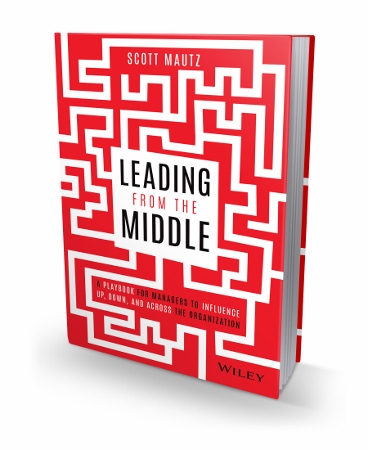
Being a leader in the soon-to-be dominant world of hybrid work (sometimes remote, sometimes in person) requires greater collaboration skills than ever. This means not only fostering a collaborative spirit, but also reconciling conflicting and changing priorities and viewpoints, and getting opposing forces with different agendas to come together as one. Without these skills, good luck getting anything done.
The obvious moves are to build a foundation of trust within the organization, to encourage innovation (which forces trial runs in collaboration), and to have the right technology tools in place to enable collaboration.
Less obvious (and just as powerful) are the methods that follow for building this critical skill, as I share in my new book, “Leading from the Middle: A Playbook for Mangers to Influence Up, Down, and Across the Organization”.
1. Provoke the big picture.
People unite when they have something bigger picture to unite for and rally behind. It can be a gripping cause or a powerful purpose, mission, or vision. It can be as simple as clear, compelling, and common goals. Whatever you rally people around, it should feel like it’s something worth fighting for, something with a personal and emotional connection, something that, if accomplished, would have meaning to the “doers.” In other words, not just a numerical target.
You further grow your collaboration skills when you consistently keep the bigger picture in front of your group. You can do that by starting every townhall or team meeting with a reminder of what the collective group is fighting for. Use the big picture as a filter by asking (before actions are taken) “Will that help us move closer towards what we’re ultimately trying to accomplish together?” Employees can easily forget the higher order objective when they’re engaged in day-to-day struggles. Never underestimate how often you should amplify the bigger picture to remind employees of the reason they need to work together.
As an example, a consumer goods company I keynoted for conducts monthly “Collaboration Communications” (as they call them), monthly companywide meetings where leaders share the big picture of what the company is trying to accomplish and why collaboration is so important (in their case it fuels innovation). They also give awards out at these sessions to employees exhibiting great collaboration, which brings us to the next point.
2. Follow the 100:1 ratio.
This means for every one grand gesture you make that demonstrates how important collaboration is, you make 100 smaller, celebratory gestures. On the grand gesture front, you might not be able to do like Apple did and build a new HQ for your company with a massive park-like open space in the middle to encourage casual run-ins and idea sharing. But you can do a smaller grand gesture, such as build a “Collaboration Corner” like another one of my clients did, complete with open meeting space, a coffee bar, and high-tech whiteboards. Or maybe your grand gesture is a day of offsite training on collaboration.
More importantly, even with bigger plays in mind, the real power comes in recognizing and rewarding collaborative behavior in smaller ways, more consistently, like my consumer goods client. You can amplify collaborative tendencies by celebrating such behavior, frequently, on the spot even, until it starts to trickle down and around and become a cultural norm.
3. Follow the 3 C’s of Collaboration.
The three C’s are Clarity of roles, Community, and Conflict. First, to enable collaboration, it’s critical to clearly define everyone’s role so each person knows their part on “the assembly line” and what the role is of others on the assembly line. This includes becoming familiar with each person’s strengths across your team and leveraging them to best achieve collective goals.
It’s also important to think community over corporation, meaning, look for opportunities to bring warmth and a sense of connectedness to your workplace to make it feel less like a cold entity. For instance, encourage open knowledge sharing, proudly celebrate successes and failures, and create opportunities to have fun and learn together. All of this helps build a shared team identity, which is like collaboration rocket fuel.
Finally, collaboration should not be confused with consensus. Research shows the ability to engage in healthy conflict is a leading indicator that a team will successfully collaborate and achieve their goals. So, it’s vital to move your group from being polite and guarded in communications with each other to being challenging (yet respectful), honest, and unafraid of productive conflict or healthy debate. There are many ways to do so.
For example, you encourage healthy debate when you ensure everyone in a debate feels heard and keeps an open mind, when you ask for data to back up opinions, when you ask others to commend versus condemn the opposing point of view, when you ask that criticism be accompanied by a new idea or suggestion to improve the original idea, when you ensure debate remains focused on the point at hand and doesn’t derail into personal attacks based on poor underlying relationships, and when you cut off “meeting hijackers” who constantly interrupt or drone on and cause others to disengage from the debate at hand.
So as hybrid work heats up, dial up your collaboration skills with these powerful tips.
Exciting News! – You Can Now PreOrder My Book, already an Amazon #1 BEST-SELLING new release in Management Science!

Leading from the Middle: A Playbook for Managers to Influence Up, Down, and Across the Organization (publication date is May 18th, 2021). Order here https://amzn.to/3as5tK8 OR… Get a massive BONUS BUNDLE by ordering 5 or more copies here: http://lftm.bulkbooks.com/ Check out a detailed book description here: https://bit.ly/2MLe5Do




Leave a Reply